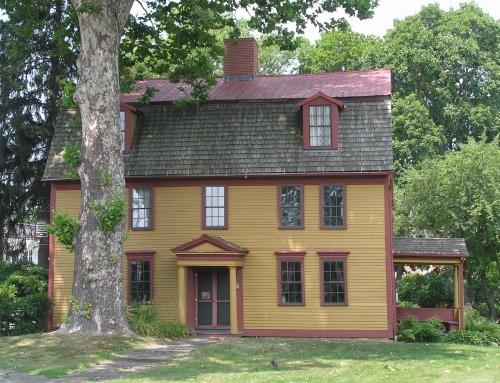Old Strong House (1744)

The gambrel-roofed dwelling known as the Old Strong House, at 67 Amity Street in Amherst, was built in 1744 by Nehemiah Strong. As related by Alice M. Walker in Historic Homes of Amherst (1905):
Samuel Strong, the ancestor of the Strongs in Amherst […], married Esther Clapp, and soon after her death took for his second wife, Mrs. Ruth Sheldon Wright. He had twelve children, most of whom settled on farms in Hadley and South Hadley. His third son Nehemiah, married about 1728 Hannah Edwards, the daughter of Jonathan French of Northampton, and widow of Nathaniel Edwards, who was killed by Indians. Unwilling for some reason to settle permanently in Northampton, Nehemiah Strong took council with his brothers, living across the river, as to the most desirable location for a home, and settled upon Hadley third precinct, where land was cheap and plentiful. He purchased a tract at the junction of the west highway and the road leading to Hadley, with the intent of building a mansion of the latest style and most approved design.
Nehemiah’s son, Simeon, a lawyer, inherited the house. Quoting again from Walker:
Young Simeon erected for himself an office on the west side of his dwelling, and it is possible made some changes in the back part of the mansion, as tradition hints that once the roof sloped to the ground.
During the Revolution:
Most prominent among the loyalists was Simeon Strong, and the old Strong house became the headquarters of the Tory faction. […] The learned advocate, honest in his convictions, in spite of his Tory principles, kept the respect of his fellow townsmen, maintained his standing at the bar and accumulated wealth. The small addition to the rear of the family mansion held his law library and pamphlets, and served him as an office. Here he interviewed his clients and pursued those studies in theology and metaphysics which were his delight to the close of his life. In 1787 Simeon Strong was appointed a member of a committee to build a new meeting house on the hill. Having served the town acceptably in the General Court, he was elected to the Senate, and in 1800 was appointed Justice of the Supreme Judicial Court of Massachusetts.